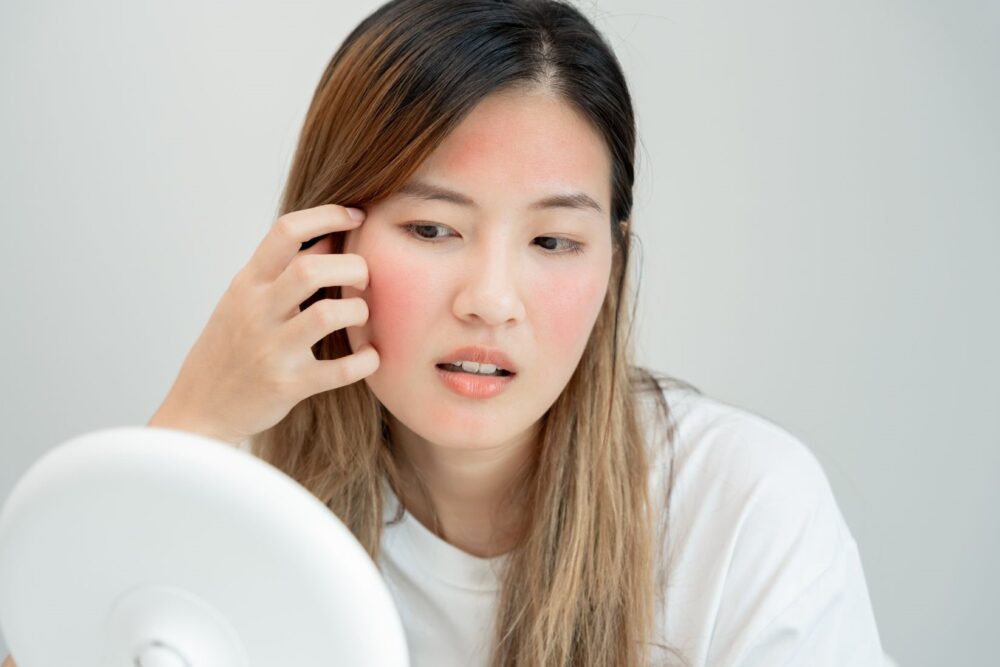Do your cheeks flush easily? Does your skin burn or sting when you apply certain products? Or maybe you’ve noticed persistent redness, tiny visible blood vessels, or even acne-like bumps that just don’t go away. If this sounds familiar, you might be dealing with rosacea, an often-misunderstood skin condition that affects millions of people yet frequently goes undiagnosed. Let’s clear the air (and your skin) on what rosacea really is and how to get it under control.
What Is Rosacea, Anyway?
Rosacea is a chronic inflammatory skin condition that primarily affects the central face: think cheeks, nose, forehead, and chin. While it’s sometimes mistaken for acne or a sunburn that won’t fade, rosacea is a distinct condition with unique causes and triggers. It’s more common in fair-skinned individuals and typically develops between ages 30 and 50, though anyone can be affected.
Why Is My Face Always Red?
Rosacea involves an overactive immune and vascular response, meaning your blood vessels are more reactive than they should be. While we don’t know the exact cause, several contributing factors are well documented:
- Genetics: Family history increases your risk.
- Vascular Dysfunction: Rosacea-prone skin has more reactive blood vessels, leading to persistent flushing.
- Microbial Imbalance: An overgrowth of skin mites (Demodex) or certain bacteria may play a role.
- Environmental Triggers: Sun, wind, temperature extremes, and spicy foods can all make things worse.
- Lifestyle Factors: Stress, alcohol (especially red wine), and hot beverages are common flare triggers.
- Irritating Products: Harsh exfoliants, fragrances, and alcohol-based skincare can worsen sensitivity.
How to Care for Rosacea-Prone Skin at Home
Rosacea isn’t curable, but it is manageable. A gentle, consistent routine and some trigger awareness can make a world of difference.
- Cleanse Carefully: Use a mild, fragrance-free cleanser that doesn’t strip or sting. Avoid washcloths or scrubbing.
- Soothe & Protect: Moisturize twice daily to strengthen the skin barrier and reduce reactivity.
- Sun Protection is Non-Negotiable: Use a broad-spectrum SPF 30+ every day. Rosacea-prone skin is especially UV sensitive.
- Avoid Triggers: Keep a journal to track what worsens your symptoms (spicy food, heat, wine, etc.).
- Use Targeted Ingredients: Look for products with niacinamide, azelaic acid, or green tea extract to calm redness. Skip alcohol, menthol, and eucalyptus.
- Say No to Scrubs: Physical exfoliants and rough towels can make redness and sensitivity worse.
When It’s Time to Call the Experts
If over-the-counter products aren’t cutting it, or if you’re noticing visible blood vessels, swelling, or eye symptoms, it’s time to bring in professional support.
At Skin and Cancer Center of Arizona, our dermatology team can:
- Confirm your diagnosis and determine your rosacea subtype
- Prescribe topical medications (like metronidazole, ivermectin, or azelaic acid)
- Offer oral medications for more inflammatory cases
- Provide in-office treatments (such as laser therapy or light-based treatments) to reduce redness and visible vessels
- Customize a skin care plan designed specifically for your sensitivity and skin goals
Rosacea can be frustrating, but it doesn’t have to be a lifelong struggle. With the right care, you can calm the redness and take back control.
Keep Learning With Us
Follow us on Instagram and Facebook for more real-world skincare education, promotions, and expert advice. Whether it’s redness, acne, or chronic sensitivity, we’ve got the tools, treatments, and experience to help you feel good in your skin again. Rosacea doesn’t define you, and with the right support, clearer days are ahead. For more information on skin health and prevention tips, visit the American Academy of Dermatology (AAD).





